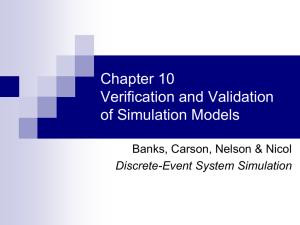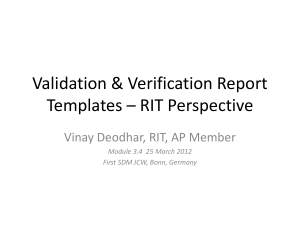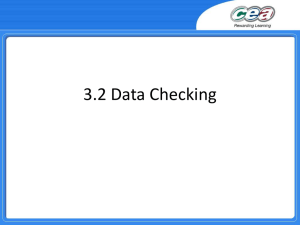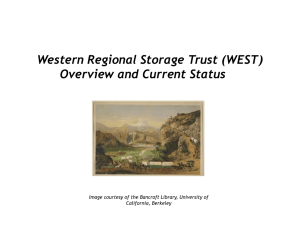Chapter10
advertisement
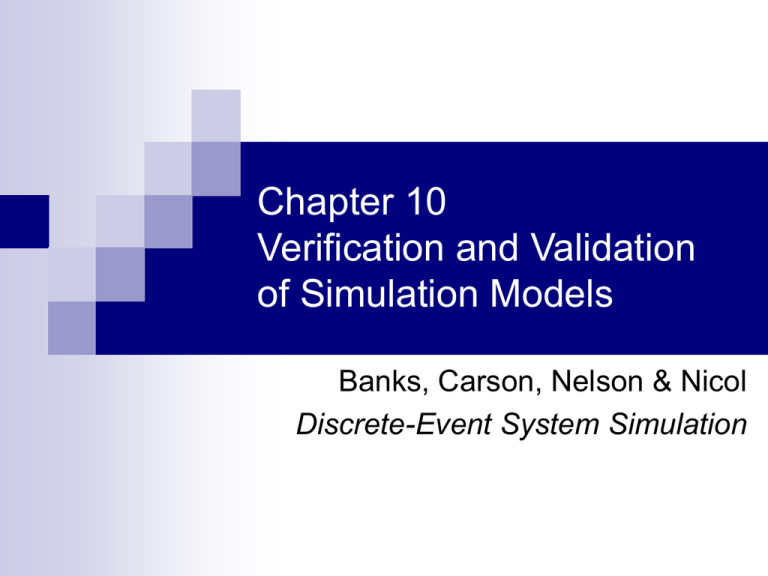
Chapter 10
Verification and Validation
of Simulation Models
Banks, Carson, Nelson & Nicol
Discrete-Event System Simulation
Purpose & Overview
The goal of the validation process is:
To
produce a model that represents true behavior
closely enough for decision-making purposes
To increase the model’s credibility to an acceptable
level
Validation is an integral part of model
development
– building the model correctly (correctly
implemented with the software)
Validation – building the correct model (an accurate
representation of the real system)
Verification
2
Modeling-Building, Verification & Validation
3
Verification - Debugging
Purpose: ensure the conceptual model is reflected
accurately in the computerized representation.
Many common-sense suggestions, for example:
Have someone else check the model.
Make a flow diagram that includes each logically possible action
a system can take when an event occurs.
Closely examine the model output for reasonableness under a
variety of input parameter settings. (Often overlooked!)
Print the input parameters at the end of the simulation, make
sure they have not been changed inadvertently.
4
Other Important Tools
[Verification]
Documentation
A means
of clarifying the logic of a model and verifying
its completeness
Use of a trace
A detailed
printout of the state of the simulation model
over time.
Animation
5
Calibration and Validation
Validation: the overall process of comparing the model and its
behavior to the real system.
Calibration: the iterative process of comparing the model to the real
system and making adjustments.
6
Calibration and Validation
No model is ever a perfect representation of the system
The modeler must weigh the possible, but not guaranteed,
increase in model accuracy versus the cost of increased validation
effort.
Three-step approach:
Build a model that has high face validity.
Validate model assumptions.
Compare the model input-output transformations with the real
system’s data.
7
High Face Validity
The model should appear reasonable to model users and
others who are knowledgeable about the system.
[Calibration & Validation]
Especially important when it is impossible to collect data from the
system
Ensure a high degree of realism: Potential users should be
involved in model construction (from its conceptualization to its
implementation).
Sensitivity analysis can also be used to check a model’s
face validity.
Example: In most queueing systems, if the arrival rate of
customers were to increase, it would be expected that server
utilization, queue length and delays would tend to increase.
8
Validate Model Assumptions
[Calibration & Validation]
General classes of model assumptions:
Structural assumptions: how the system operates.
Data assumptions: reliability of data and its statistical analysis.
Bank example: customer queueing and service facility in a
bank.
Structural assumptions, e.g., customer waiting in one line versus
many lines, served FCFS versus priority.
Input data assumptions, e.g., interarrival time of customers, service
times for commercial accounts.
Verify data reliability with bank managers.
Test correlation and goodness of fit for data (see Chapter 9 for more
details).
9
Validate Input-Output Transformation
[Calibration & Validation]
Goal: Validate the model’s ability to predict future behavior
The only objective test of the model.
The structure of the model should be accurate enough to make
good predictions for the range of input data sets of interest.
One possible approach: use historical data that have been
reserved for validation purposes only.
Criteria: use the main system responses of interest.
10
Bank Example
[Validate I-O Transformation]
Example: One drive-in window serviced by one
teller, only one or two transactions are allowed.
Data
Observed service times {Si, i = 1,2, …, 90}.
Observed interarrival times {Ai, i = 1,2, …, 90}.
Data
collection: 90 customers during 11 am to 1 pm.
analysis let to the conclusion that:
Interarrival times: exponentially distributed with rate l = 45
Service times: N(1.1, 0.22)
11
The Black Box
[Bank Example: Validate I-O Transformation]
A model was developed in close consultation with bank
management and employees
Model assumptions were validated
Resulting model is now viewed as a “black box”:
Model Output Variables, Y
Input Variables
Uncontrolled
variables, X
Controlled
Decision
variables, D
Possion arrivals
l = 45/hr: X11, X12, …
Services times,
N(D2, 0.22): X21, X22, …
D1 = 1 (one teller)
D2 = 1.1 min
(mean service time)
D3 = 1 (one line)
Model
“black box”
f(X,D) = Y
Primary interest:
Y1 = teller’s utilization
Y2 = average delay
Y3 = maximum line length
Secondary interest:
Y4 = observed arrival rate
Y5 = average service time
Y6 = sample std. dev. of
service times
Y7 = average length of time
12
Comparison with Real System Data
[Bank Example: Validate I-O Transformation]
Real system data are necessary for validation.
Average delays should have been collected during the same time
period (from 11am to 1pm on the same Friday.)
Compare the average delay from the model Y with the
actual delay Z:
Average delay observed, Z = 4.3 minutes, consider this to be the
true mean value m0 = 4.3.
When the model is run with generated random variates X1n and
X2n, Y should be close to Z.
Six statistically independent replications of the model, each of 2hour duration, are run.
13
Hypothesis Testing
[Bank Example: Validate I-O Transformation]
Compare the average delay from the model Y with the
actual delay Z (continued):
Null hypothesis testing: evaluate whether the simulation and the
real system are the same (w.r.t. output measures):
H 0 : E(Y) 4.3 minutes
H1 : E(Y) 4.3 minutes
If H0 is not rejected, then, there is no reason to consider the
model invalid
If H0 is rejected, the current version of the model is rejected,
and the modeler needs to improve the model
14
Hypothesis Testing
[Bank Example: Validate I-O Transformation]
Average Delay Times
Y1, Y2, …, Y6 iid random variables
Simulation Model
Replication
Average Delay
Replication
Average Delay
1
2.79
4
3.45
2
1.12
5
3.13
3
2.24
6
2.38
15
Hypothesis Testing
[Bank Example: Validate I-O Transformation]
Conduct the t test:
Choose level of significance (a = 0.5) and sample size (n = 6).
Compute the same mean and sample standard deviation over
the n replications:
1/ 2
n
Y
Student’s t
distribution
n
1
Yi 2.51 minutes
n i 1
Compute test statistics:
t0
Y m0
S/ n
2.51 4.3
0.82 / 6
2
(Yi Y )
S i 1
n 1
0.81 minutes
5.24 ta / 2,n1 2.571
Hence, reject H0. Conclude that the model is inadequate.
Check: the assumptions justifying a t test, that the observations
(Yi) are normally and independently distributed.
16
Type II Error
[Validate I-O Transformation]
For validation, the power of the test is:
detecting an invalid model ] = 1 – b
b = P(Type II error) = P(failing to reject H0|H1 is true)
Consider failure to reject H0 as a strong conclusion,
the modeler would want b to be small.
Value of b depends on:
Sample size, n
The true difference, d, between E(Y) and m:
Probability[
d
E (Y ) m
17
Type I and II Error
[Validate I-O Transformation]
Type I error (a):
Type II error (b):
Error of rejecting a valid model.
Controlled by specifying a small level of significance a.
Error of accepting a model as valid when it is invalid.
Controlled by specifying critical difference and find the n.
For a fixed sample size n, increasing a will decrease b.
For a fixed critical difference and a, increasing n will
decrease b.
18
Using Historical Output Data
[Validate I-O Transformation]
An alternative to generating input data:
Use the actual historical record.
Drive the simulation model with the historical record and then
compare model output to system data.
In the bank example, use the recorded interarrival and service
times for the customers {An, Sn, n = 1,2,…}.
Define Zi to be the actual average delay for the ith data
set, Yi to be the simulated average delay for the ith data
set, and di Zi Yi . Conduct the t-test for
H 0 : E(d) 0
H1 : E(d) 0
19
Summary
Model validation is essential:
Model verification
Calibration and validation
Conceptual validation
Best to compare system data to model data, and make
comparison using a wide variety of techniques.
Some techniques that we covered (in increasing cost-tovalue ratios):
Insure high face validity by consulting knowledgeable persons.
Conduct simple statistical tests on assumed distributional forms.
Compare model output to system output by statistical tests.
20

